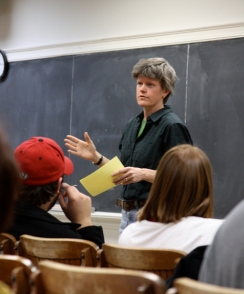October 2010 – The Next Generation of Science Textbooks?
 Will the next generation of science textbooks use stories to teach? Will they be successful?
Will the next generation of science textbooks use stories to teach? Will they be successful?
Associate Professor and Director of the Institute for Cross-College Biology Education (ICBE) Teri Balser is co-author of a new and experimental introductory environmental studies textbook designed to marry narrative and story with infographics and pedagogical devices and features. The project represents a partnership between Scientific American and WH Freeman, and a collaboration between science writers and science faculty. Join us for a sneak preview of the project and a discussion about the future of textbooks, and how we might incorporate learning through story in the sciences.
Join the Learning Through Story discussion on Tuesday, October 12, Noon – 1:00, Teacher Education building, room 220.
Resources:
http://digicoll.library.wisc.edu/SouAfrVc
davidmchugh said
Notes from the discussion:
How do we teach science? (what associations do you have?)
What it’s like:
• Process – scientific method
• Memorization
• Fact
• Order
• Experiments
• Removed from day to day life (decontextualized)
• Data
• Labs
• Stories
• History
• Theory
• Research
What we wish it was like:
• Relevant
• Understandable
• Curiosity
• Playful
• “Synthegrative”
• Interactive
• Connected
• Animated
• Applied
• Conceptual
• Engaging
• Fun
• Collaborative
• Reframing failure
• Dissonant
• Creative
Why was the second list so much easier to come up with?
• We think more about the what-ifs; it’s more fun to think about what we wish it was like
• There’s more of an emotional connection than the cognitive process of analyzing the other type
Do students learn less if they enjoy themselves?
o “If they have fun learning you can’t stop them from learning” – Teri
• Remove fear, replace it with positive emotions and curiosity
• “Hook it to something emotional” – Grabs attention
How can stories help students learn?
o Form connections.
o Story has a structure – we can hang the pieces of knowledge on it. This integrates it and brings the individual pieces together.
o We use them to build community. Seeing yourself in the various roles has intrinsic purposes in connecting us to the materials in different ways.
Is it worth making a distinction between a story that teaches and a story that motivates them to learn?
o Different purposes
o Different types of stories for different types of learning
o Motivation to learn is part of learning
o Tie in personal relevance – Otherwise you can’t retain it, won’t use it
o Exemplar learning – we pay more attention to conversations/story, than to mere facts, even if all else is equal.
What are the characteristics of story that makes it useful? Why?
o Relevance – makes them care
o Structure/framework – integrates info into existing structures or creates framework
o Role of anthropomorphism?
o Involves change. Need for success/failure
o Narrative arc/trajectory – directionality. Can pick out what’s important.
• Build mystery/intrigue to capture attention
• The Central Question – helps you find places for related info without it being overwhelming
o Invokes images/use of senses – adds dimension to the material
o Creates empathy with the material
o Fosters critical thinking – how will the story resolve?
o Stories make it easier to ask questions
o Bridges affective/analytical in order to information
o Repetition
o It’s a format that our brains are wired/evolved to understand
o Provides pacing
Disadvantages?
o Stories often contain fiction – when mixing stories with science, students have to be able to distinguish between the two.
o Metaphors can be carried too far, easily
• Feedback an important part of the process – need to make sure they’re making the right connections
• Interaction important
• By participating they also learn more, create meaning
o Might not be equally received based on people’s background – students from a different culture may not catch references
o Doesn’t work well for certain things (visual learning)
o Time consuming
o May oversimplify the material
The problem isn’t obtaining the facts – the world abounds with them. It’s knowing what to do with them. How to integrate them.
Final Thoughts/Questions
o Could we base textbooks on a narrative arc?
o Comparative utility of textbooks as teaching tools vs. as reference?
o Use of conflicting narratives – provide a story arc from which you have to provide resolution. Have to reconcile differing views. This fosters critical thinking.